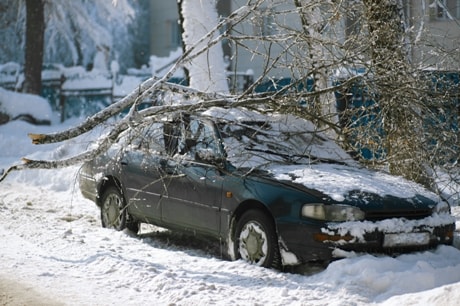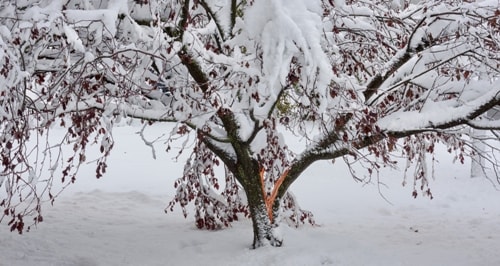
Winter storms can cause major damage to trees and shrubs. Strong winds can uproot trees and break branches. Cold temperatures and rapid temperature fluctuations can freeze tree roots or cause frost cracks in branches. Heavy snow can freeze leaves and branches as well as deform trees due to extra weight. Ice buildup can make tree branches more brittle and susceptible to breaking, especially combines with wind. Sidewalk salt can cause leaf drying and damage, and can alter soil compositions. Keeping trees free of snow and ice, keeping roots insulated can help prevent damage from winter storms. Trimming small broken branches behind the break can help trees heal faster. Call Great Northern Greenery at 905-775-7444 for more information.
Damage after a severe winter storm can cause trees to be seriously disfigured and can even lead to the death of the plant if not repaired immediately. We found 5 ways that winter storms cause damage to trees and what can be done to fix it.
1. Wind Damage
Wind can cause drying to the leaves and branches of some trees, causing browning of affected areas. In worst case scenarios strong winds can uproot trees. Exposed roots are much more susceptible to cold damage.
2. Snow Damage
Weight from heavy snow on branches can permanently deform trees. Trees with broad branches and flatter leaves are more susceptible to this type of damage. Snow can also cause cold damage, although when the plant is completely covered in snow it can have an insulating effect.
3. Ice damage
Ice causes damage by making tree branches brittle and susceptible to breaking. Ice accumulation can also be heavy enough to split trees, especially when combined with high winds.

4. Cold Temperatures and Rapid Temperature Fluctuations
Rapid changes in temperature can cause major tree damage. Frost cracks, lengthwise splits in the outer surface of trees, can occur when layers of the tree contract differently. These cracks may heal but they usually return annually.
5. Sidewalk Salt
Sidewalk salt used to thaw out icy build ups can be harmful to plant leaves. It causes excessive drying of the leaves, resulting in browning and can alter soil composition.
After a winter storm, there a few things you can do to try to help your trees. If there is snow build up on branches, use a broomstick to gently shake it off. If trees are entirely covered in snow, it is best to leave them alone. Trimming broken branches behind the break can help the tree heal as fast as possible. For more severe tree damage, exposed roots or large broken branches, it is best to contact your arborist for tree repair. Your friends at Great Northern ReGreenery would love to be of service to you. Please call us at 905-775-7444.





